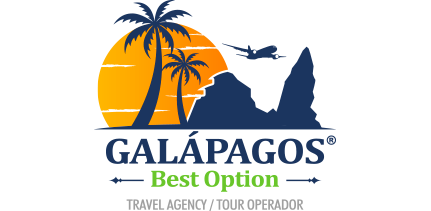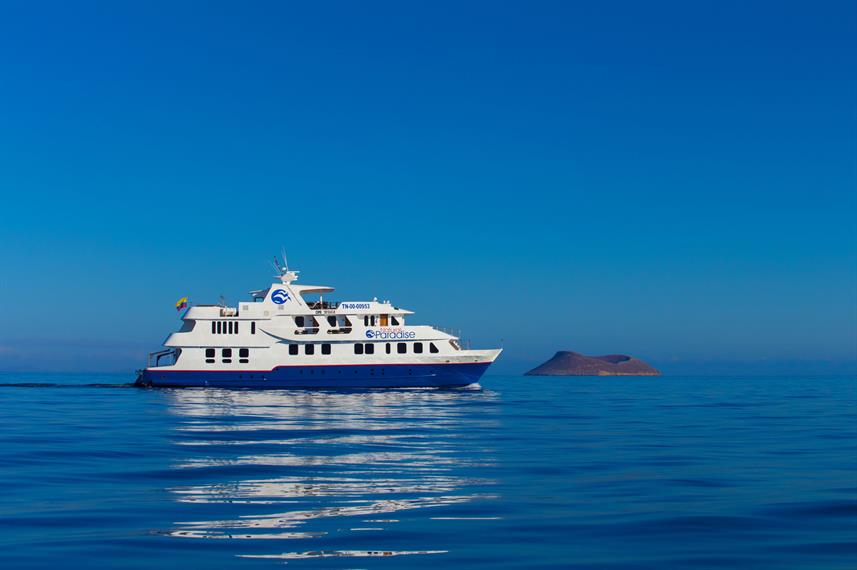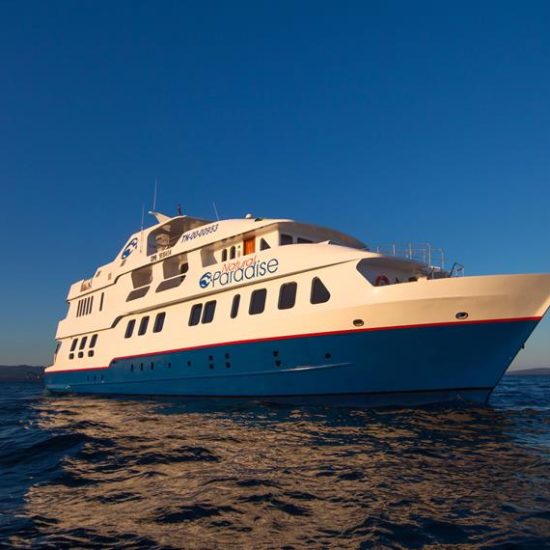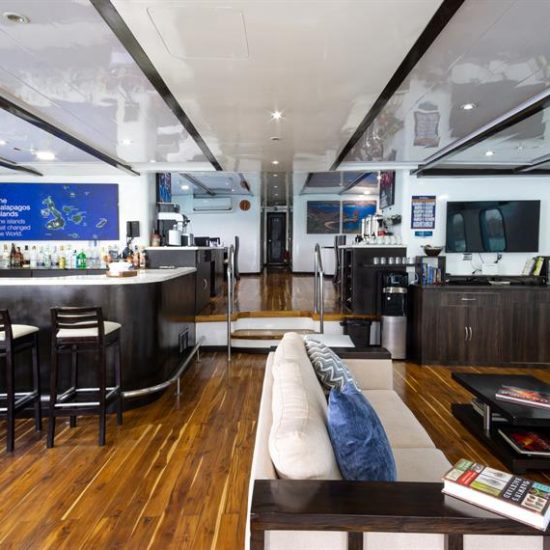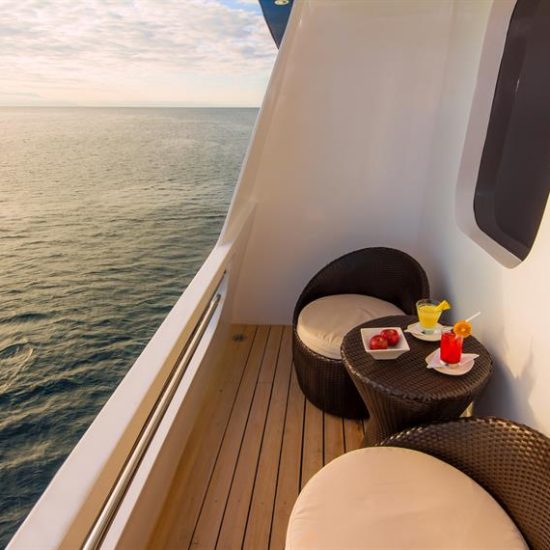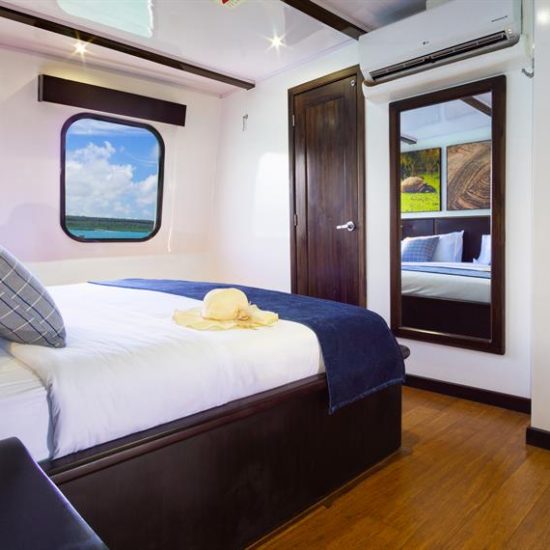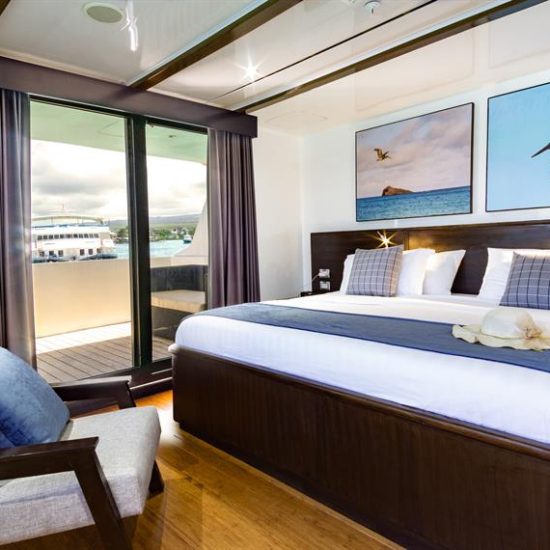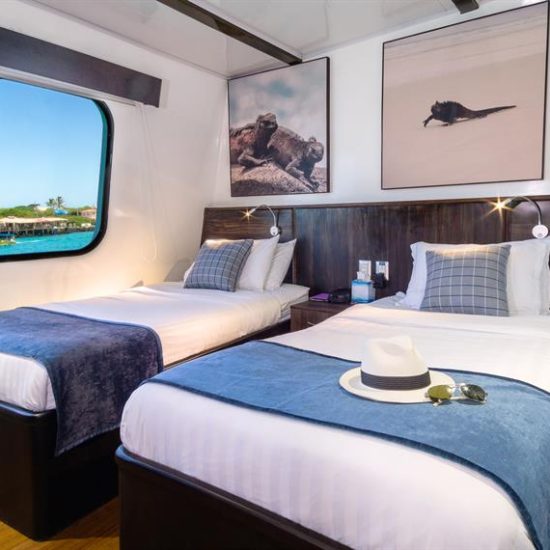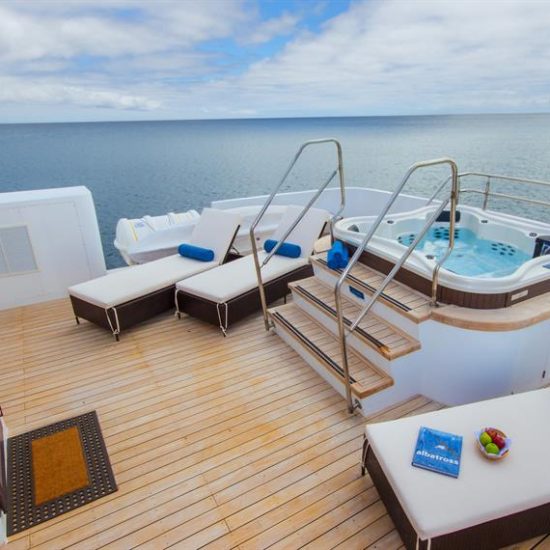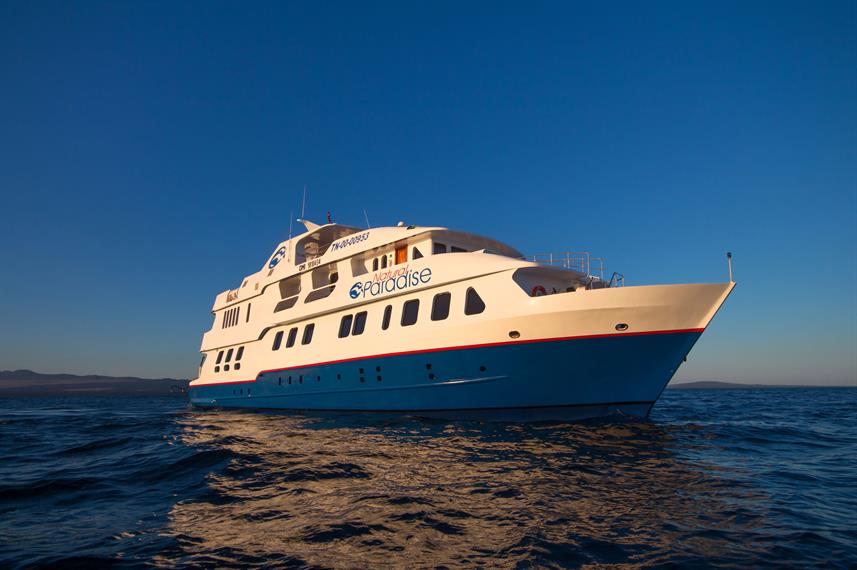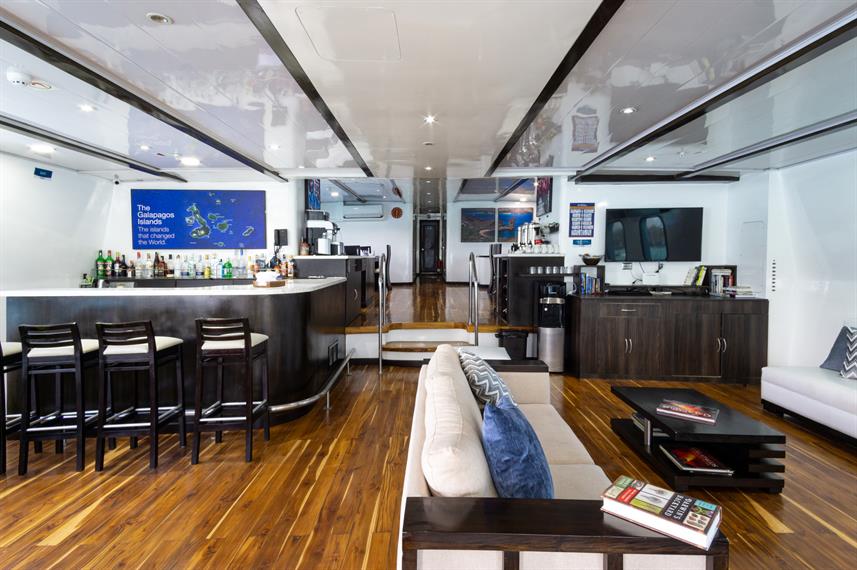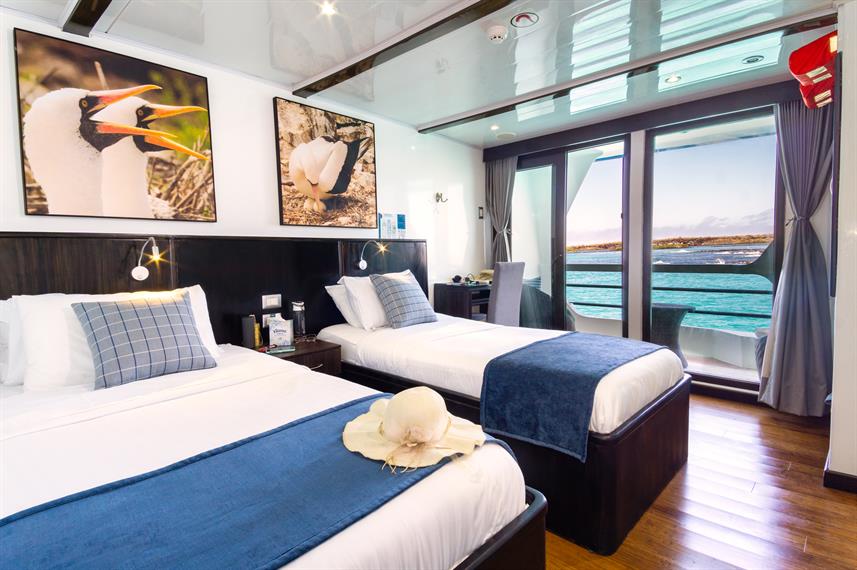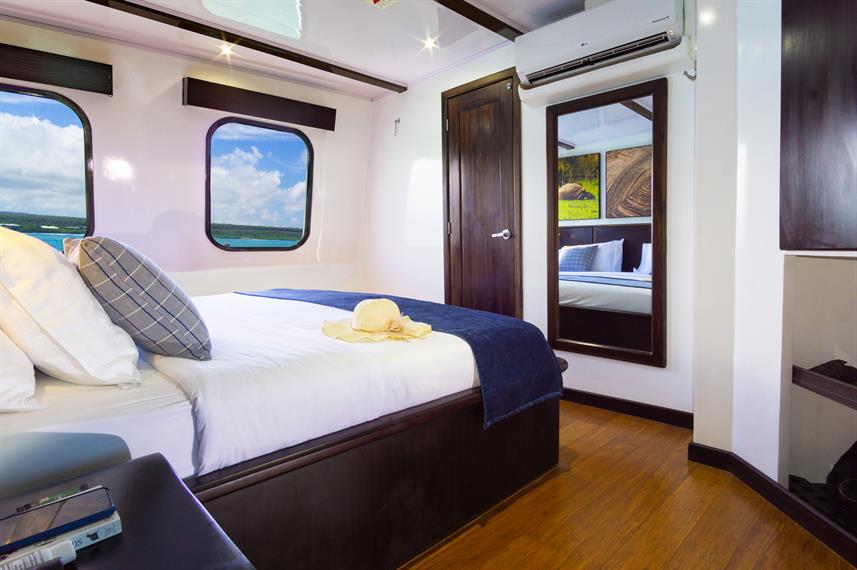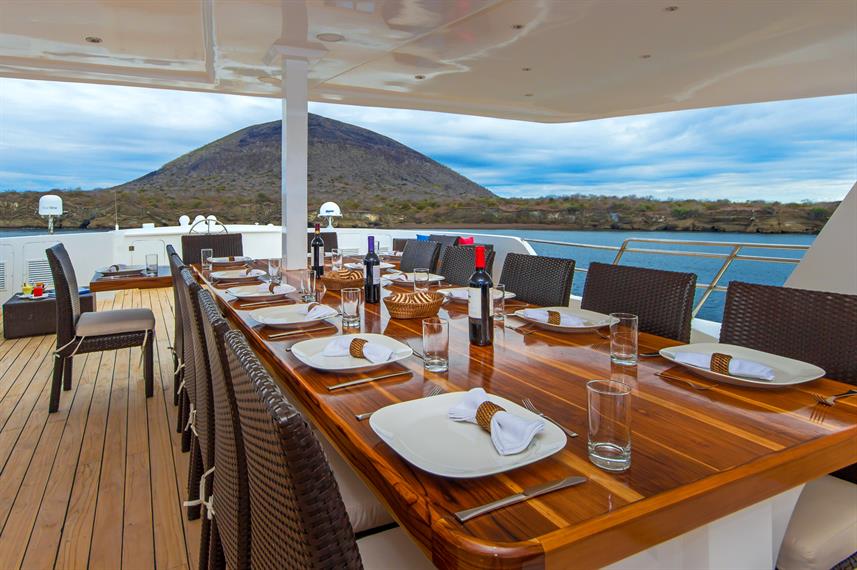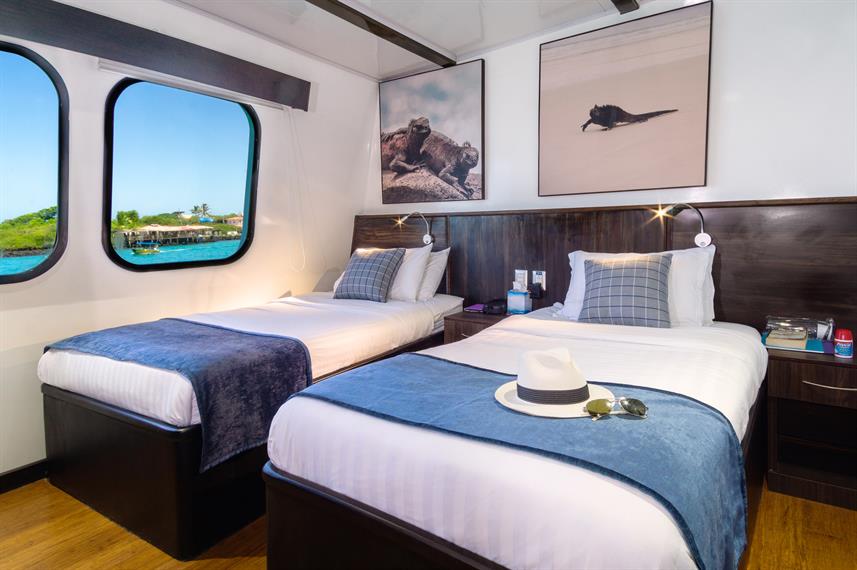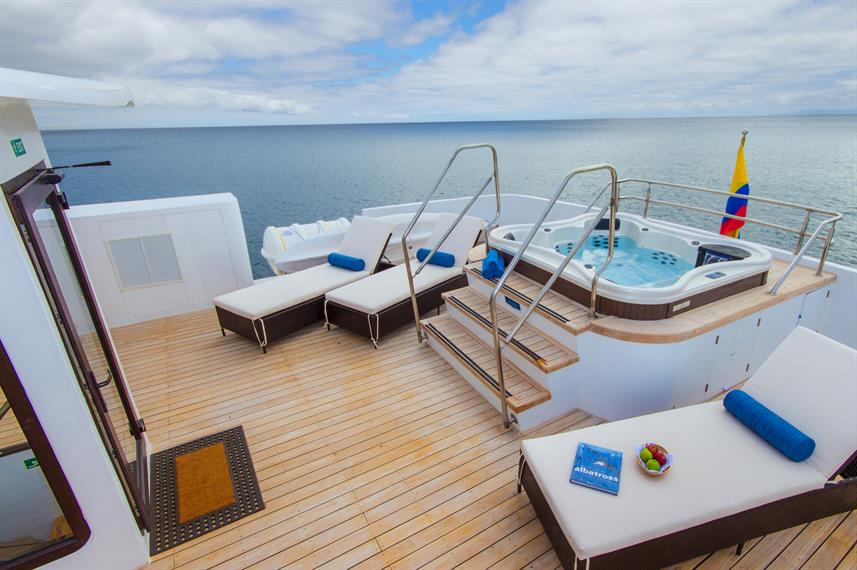The Natural Paradise, built in 2016, is a modern luxury yacht with 9 stylish cabins and excellent facilities. With room for up to 16 guests and stylish and comfortable features, each stateroom has a private bathroom, air conditioning and plenty of storage. Upper deck staterooms have private balconies. Guests can relax in the solarium with jacuzzi or in the lounge/bar. There are outdoor and indoor dining areas. There are snorkeling equipment and wet suits for the use and enjoyment of guests, allowing them to be fascinated by the incredible marine life that exists in the waters that we navigate. In addition, they will be able to use the cameras that we carry on board.
RESERVE THIS CRUISE
Starting Price Per Person: $2.199,00 USD, all taxes are included.
Please confirm availability for your desired itinerary by contacting us at:
info@galapagosbestoption.com / sales@galapagosbestoption.com / Whatsapp +593 967742545
PAYMENT POLICY
To book and confirm any tour, we must receive 100% of the total amount prior to the tour as follows:
50% due at the time of booking
50% due two weeks before the date of your tour
CANCELLATIONS
Any last minute cancellations or changes by the customer may incur a fee to be imposed by Galapagos Best Option SA.
If for any reason a passenger is not present at the time of their flight they will be considered a no show and will not be subject to any refund by the agency.
Please read our full Cancellation and Refund Policy.
The Galapagos National Park has the right to make any changes to the itinerary due to natural disasters or scientific research projects.
ITINERARY SAN CRISTOBAL ISLAND
Day 1 (Tuesday): Santa Cruz Island
Guests are required to book the 06.50 am flight from Quito (UIO) to Baltra (GPS) to arrive by 9.20 am.
Morning flight from Quito or Guayaquil to Baltra, Galapagos Islands. You will arrive at Baltra Island in the morning. After passing through immigration and baggage claim, you will be met by the Natural Paradise staff and transferred to the yacht. You will be shown to your cabin where you will have some time to settle in before lunch and a welcome briefing.
In the afternoon, off the western coast of Santa Cruz Island, Eden Islet offers visitors a great chance to see a variety of Galapagos wildlife from the dinghy ride both onshore and under the water.
Eden Islet
- Activities: Dinghy ride and snorkeling
- Difficulty: Easy
- Type of Landing: No landing
- Highlights and Animals: Endemic salemas, reef sharks, Nazca, and blue-footed boobies
Day 2 (Wednesday): Isabela & Fernandina Islands
In the morning, a visit to Vicente Roca Point. Located on the northwestern coast of the island and comprised of two separate coves, this site is a large bay with spectacular sea life. Seahorses, sea turtles, and the strange yet fascinating Mola mola (sunfish) may be spotted here. This bay is great for diving and snorkeling.
Vicente Roca Point
- Possible Activities: Snorkeling & dinghy ride
- Difficulty: Easy / Moderate
- Type of Landing: No landing
- Highlights and Animals: Penguins, blue-footed boobies, terns, Nazca boobies, two types of sea lions. sea turtles, rays, and pufferfish.
In the afternoon, crossing the Bolivar Channel that divides Isabela and Fernandina Islands, you will land at Espinosa Point. No foreign species have ever invaded Fernandina Island, and therefore it is one of the world's most pristine island ecosystems. The volcano “La Cumbre” dominates the land space with lava fields reaching the ocean. The island's highlight features the flightless cormorant nesting site. This area provides a great opportunity to see the Galapagos hawk.
Espinosa Point
- Possible Activities: Hike of approximately (1.2 miles / 2 km)
- Difficulty: Moderate
- Type of Landing: Dry and slippery at low tide
- Highlights & Animals: Flightless cormorant, marine iguanas, ‘a‘ā lava, sea lions, penguins, active volcano “La Cumbre”.
Day 3 (Thursday): Isabela Island
In the morning, you will go to Urbina Bay which is located at the base of Alcedo Volcano on the west coast between Tagus Cove and Elizabeth Bay. This area experienced a major uplift in 1954 causing the land to rise over 16 feet. The coast expanded half a mile out leaving marine life stranded on the new shore. This area is also a great place for snorkeling.
Urbina Bay
- Possible Activities: Snorkeling, dinghy ride & hike, 2 trails: short (0.6mi/1 km), long (1.9mi/3km)
- Difficulty: Easy/Moderate
- Type of Landing: Wet landing
- Highlights & Animals: Land iguanas (the biggest in the Galapagos), hawks, coral reef, giant tortoises; snorkeling: turtles, rays, tropical fish
In the afternoon, you will visit Moreno Point located near Elizabeth Bay on the west coast of Isabela Island. The plethora of birds seen during a dinghy ride along the striking rocky shores or a hike along the path through lava rock leading to tide pools and mangroves create a birdwatcher’s delight. In the tide pools, green sea turtles or white-tip sharks can be spotted.
Moreno Point
- Possible Activities: Snorkeling, dinghy ride & hike
- Difficulty: Moderate / difficult
- Type of Landing: Dry landing
- Highlights & Animals: Flamingos, gallinules, pintail ducks, turtles, white-tip reef sharks.
Day 4 (Friday): Isabela Island
The morning will consist of a visit to The Sierra Negra Volcano which is the largest basaltic caldera in the Galapagos with a diameter of 6.2 miles (10 km). The site offers impressive views and the opportunity to observe up to seven species of finches and a rich display of vegetation. The north side of the caldera provides evidence of its most recent volcanic activity in 2005.
The Sierra Negra Volcano
- Possible Activities: Hiking, walking
- Difficulty: Moderate
- Type of Landing: Dry landing
- Highlights & Animals: Basaltic caldera, stunning views, finches
In the afternoon, you will visit The Wetlands of Isabela Island, located just outside of Puerto Villamil. The Wetlands consist of lagoons, swamps, and mangroves and are home to a variety of unique bird species such as common stilts, whimbrels, white-cheeked pintails, and gallinules. The Wetlands can be visited on foot via a path that winds through the swamps.
The Wetlands (Puerto Villamil)
- Possible Activities: Hiking
- Difficulty: Easy
- Type of Landing: Dry landing
- Highlights & Animals: Giant mangroves, shorebirds
Next, you will visit the Tortoise Breeding Station (Puerto Villamil). This center was created to protect animals in their first years of life from the threats of foreign species such as pigs and donkeys. Giant tortoise eggs are collected and brought to the center where they are hatched and kept for five years before being released to their natural environment.
Tortoise Breeding Center
- Possible Activities: Walking
- Difficulty: Easy
- Type of Landing: Dry landing
- Highlights & Animals: Two of the five subspecies of the giant tortoise
Day 5 (Saturday): Chinese Hat & Mosquera Islets
In the morning, you will visit the Chinese Hat Islet. This small islet is located near the southeast coast of Santiago Island. Its name comes from the distinct shape of the islet’s summit. This small islet is a great location to view many geological formations such as lava tubes and lava flows.
Chinese Hat Islet
- Possible Activities: Hike & snorkeling (1,9 miles / 3 km)
- Difficulty: Easy/Moderate
- Type of Landing: Wet landing
In the afternoon, you will visit Mosquera Islet, which is located between the islands of Baltra and North Seymour, this reef of rocks and coral (the result of an uprising) is only 160 meters across at its narrowest width. This island has one of the largest populations of sea lions and is home to many shorebirds. There have been occasional reports at this site of orcas feeding on sea lions.
Mosquera Islet
- Possible Activities: Dinghy ride, snorkeling
- Difficulty: Easy
- Type of Landing: No landing
- Highlights & Animals: sea lions, shorebirds
Day 6 (Sunday): Floreana Island
In the morning, you will visit the famous Post Office Bay. You will land on a beach and head to a spot where 18th-century whalers placed a wooden barrel used as an unofficial mailbox. The custom continues to this day with Galapagos visitors. So, don’t forget your postcards, and don’t be surprised if the postcard arrives at its destination before you even get home!
In the afternoon, you will head to Cormorant Point. This site hosts a large flamingo lagoon where other birds such as common stilts and white-cheeked pintails can also be seen. The beaches on this island are distinct: The “Green Beach” named so due to its green color, which comes from a high percentage of olivine crystals in the sand, and the “Four Sand Beach” composed of white coral.
Post Office Bay & Cormorant Point
- Possible Activities: Hiking, dinghy ride
- Difficulty: Easy
- Type of Landing: Wet landing
- Highlights & Animals: Post office barrel, nice sandy beach, Flamingos, green-colored beach
Afterward, you will visit Champion Islet, named after the whaler Andrew Champion, is a small island located just offshore Floreana Island in the southern part of the Archipelago, considered as one of the most beautiful places on Galapagos for all snorkeling and diving fans and an excellent opportunity for dolphin watching.
Champion Islet
- Possible Activities: Snorkeling and dinghy ride
- Difficulty: Moderate / Difficult
- Type of Landing: Wet landing
- Highlights & Animals: Sea lions, reef fish, and Nasca boobies
Day 7 (Monday): Española Island
In the morning, you will visit Suarez Point. This area is great for spotting blue-footed boobies, albatrosses, and Nazca boobies. A beautiful sight on the oceanfront, the large waved albatrosses use the cliff as a launching pad. The famous attraction is the magnificent blowhole, spurting water high into the air. This site presents wonderful photograph opportunities.
Suarez Point
- Possible Activities: Hike (1,9 miles / 3 km)
- Difficulty: Difficult
- Type of Landing: Dry landing
- Highlights & Animals: Hood mockingbirds, Nazca boobies, waved albatrosses (from the last week of April until the last week of January), red-billed tropicbirds, lava lizards, Galapagos hawks, blue-footed boobies, blowhole, amazing landscape
In the afternoon, an excursion takes you to the spectacular Gardner Bay, on the eastern side of the island, which is the breeding site of nearly all of the world´s 12,000 pairs of waved albatrosses. It has an ample white sandy beach with a myriad of sea lions, perfect for relaxing. Its rocky shores make this site a great place for diving and snorkeling.
Gardner Bay
- Possible Activities: Snorkeling, dinghy ride, kayaking, a short hike of (0.6 miles/1 km)
- Difficulty: Easy
- Type of Landing: Wet landing
- Highlights & Animals: White sandy beach, sea lions, mockingbirds; snorkeling: colorful fish, sea lion nursery
Day 8 (Tuesday): San Cristobal Island
In the morning, you will involve an excursion to Lobos Island which means “Sea Lion Island.” This appropriately named island is ripe with noisy, playful, jolly sea lions who will welcome you to their home with open, well, fins. This island also offers great snorkeling opportunities as well as the chance to see blue-footed and Nazca boobies.
Lobos Island
PRICE : 7.499,00 USD P.P.
ITINERARY B
4 DAYS
Day 1 (Saturday): Santa Cruz Island
Guests are required to book the 08.15 am flight from Quito (UIO) to Baltra (GPS) to arrive by 10.50 am.
Morning flight from Quito or Guayaquil to Baltra, Galapagos Islands. You will arrive at Baltra Island in the morning. After passing through immigration and baggage claim, you will be met by the Natural Paradise staff and transferred to the yacht. You will be shown to your cabin where you will have some time to settle in before lunch and a welcome briefing.
Your afternoon excursion takes you to Santa Cruz Highlands that is reached by bus from Puerto Ayora, the highlands of Santa Cruz are a deep green contrasting beautifully with much of the dry, lower islands. The dominant vegetation in the highlands is the forest of Scalesia trees creating the lush green color. The lava tubes, over half a mile long, are underground, and walking through them is a unique, surreal experience.
Santa Cruz Highlands
- Possible Activities: Hike (1.5 miles/ 2 ½ km)
- Difficulty: Moderate (long)
- Type of Landing: Dry landing
- Highlights & Animals: Lava tunnels, wild turtles, tortoises breeding center
Then, you will visit the Fausto Llerena Breeding Center in Puerto Ayora, Santa Cruz Island. The Charles Darwin Research Station is home to turtles ranging from 3-inches (new hatchlings) to 4-feet long. Subspecies of turtles interact with one another and many of the older turtles are accustomed to humans stretching out their heads for a photo opportunity. The babies are kept until they are about four years old and strong enough to survive on their own.
Charles Darwin Station / Fausto Llerena Breeding Center
- Possible Activities: Walking
- Difficulty: Easy
- Type of Landing: Dry landing
- Highlights & Animals: Giant tortoises in captivity
Day 2 (Sunday): Genovesa Island
In the morning, you will visit El Barranco which is also known as Prince Phillip’s Steps. It is a steep, rocky path that leads up to a high cliff-face. A marvelous view can be appreciated from here. This site is also home to palo santo vegetation as well as red-footed boobies, short-eared lava owls, Galapagos swallows, and Galapagos doves.
El Barranco
- Possible Activities: Hiking (0,9 miles / 2 Km)
- Difficulty: Moderate
- Type of Landing: Dry, difficult landing
- Highlights & Animals: Red-footed boobies, short-eared lava owls, storm-petrels, Galapagos doves
In the afternoon, you will visit the white-sand coral beach of Darwin Bay which heads a half-mile trail (0,75km) that winds through mangroves filled with land birds. Nazca boobies, red-footed boobies, and swallow-tailed gulls can be spotted here. Further down the path, we’ll find tidal pools where sea lions swim playfully. At the end is a spectacular view of a cliff.
Darwin Bay
- Possible Activities: Hiking (0,9 miles / 1,5 Km), snorkeling, kayaking, and dinghy ride
- Difficulty: Easy/moderate
- Type of Landing: Wet landing
- Highlights & Animals: Nazca boobies, red-footed boobies, swallow-tail gulls, mangroves, coral pebble beach, snorkeling: rays, colorful reef fish, and hammerhead sharks
Day 3 (Monday): Santiago Island
In the morning, a visit is to Espumilla Beach where the marine iguana's lounge and the Sally Lightfoot crabs attract the hunting herons performing the dance of predator and prey right before your eyes. Snorkeling is highly recommended as you could and yourself face to face with an octopus, moray eel, shark, and a variety of other species of tropical fish.
Espumilla Beach
- Activities: Snorkeling and swimming
- Difficulty: Easy
- Type of Landing: Wet landing
- Highlights & Animals: Snorkeling
Buccaneer Cove is a testament to the fact that Santiago Island was once a refuge for British buccaneers. These pirates would anchor in the protected bay to make repairs and stock up on tortoise meat among other things. The steep cliffs, where hundreds of seabirds perch in front of the dark red sand beach, are magnificent sites.
Buccaneer Cove
- Activities: Short walk along the beach (less than 0.6 miles/1 km)
- Difficulty: Easy
- Type of Landing: Wet landing
- Highlights & Animals: Sea birds, historical site, snorkeling, rock formations
In the afternoon, you will go to Egas Port, also known as James Bay, on Santiago Island which is home to the curious Galapagos hawks and quick-footed Galapagos lava lizards. The trail leads to the coastline with gorgeous tide pools and grottos full of fauna. Here the Galapagos fur sea lions bathe in the sun. This is also a great snorkeling site.
Egas Port
- Activities: Snorkeling, hiking (1.2 miles/2 km)
- Difficulty: Easy / moderate
- Type of Landing: Wet landing
- Highlights & Animals: Fur sea lions, Galapagos sea lions, tidal pools and grottos, Galapagos hawks, oystercatchers, marine iguanas, finches; snorkeling: reef sharks, turtles, rays, nice underwater formations.
Day 4 (Tuesday): Santa Cruz Island
The morning visit, Bachas Beach, is located on the north shore of Santa Cruz which is a swimming beach. One of the few remnants of the U.S. World War II presence in the Galapagos, a floating pier, can be seen here. You may see flamingos, Sally Lightfoot crabs, hermit crabs, black-necked stilts, and whimbrels. Sea turtles also nest on the beach.
PRICE : 3.99,00 USD P.P.
- Airport Transfers
- Naturalist Guide Certified by the Galapagos National Park
- Full Meals
- Coffee, Tea and Snacks
- Snorkel Gear (Mask, Fins and Snorkel)
- Wetsuit
- Private Bathroom With Hot Water
- Air Conditioning
- Entrance Fee to Galapagos National Park $100 USD
- Immigration Control Card $20 USD
- Personal Expenses
- Tips for the Crew and Guide
- Galapagos Flights ($450 to $550 USD – ask us for a quote!)
- Alcoholic Beverages and Soft Drinks

